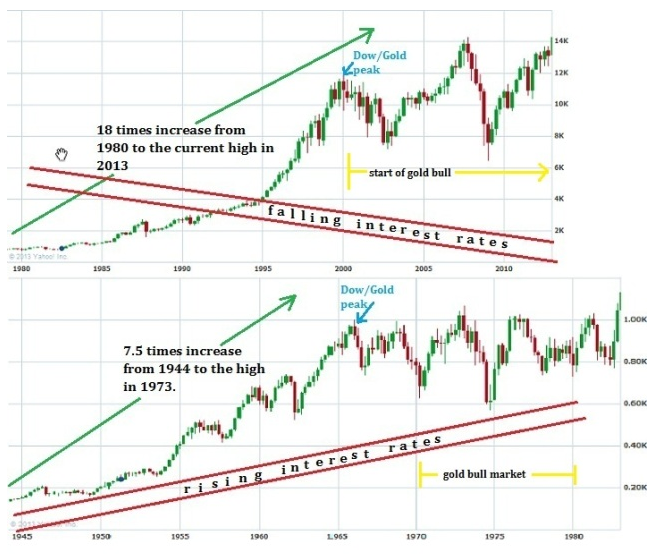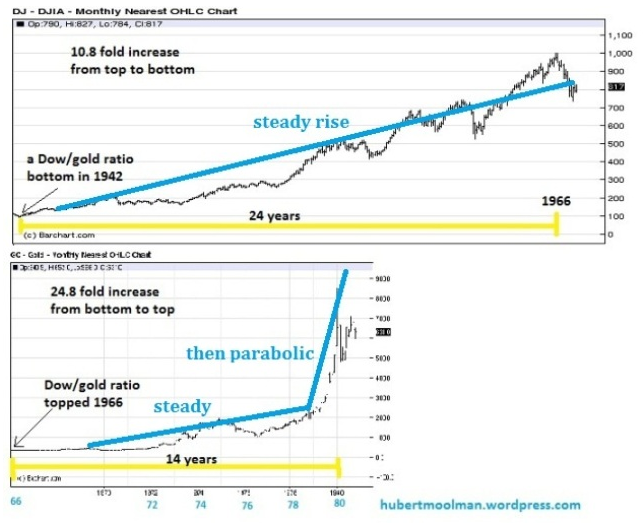The last three major bull markets of the Dow were followed by some type of economic crisis and a major bull market in gold. This is no coincidence, since these massive bull markets have been mostly driven by the huge expansion of the money supply. When this expansion of credit is exhausted, confidence fails, causing a massive economic crisis and a rush to gold. We are still in the midst of the latest crisis.
The Dow’s last two bull markets are of interest due to the significance of their relation to the current monetary system. In 1944, a new global monetary order was established with the Bretton Woods agreement. The world had just come out of the Great Depression, and the Second World War was ending.
The creation of the new global monetary order was indeed a fresh start. The Bretton Woods system brought about an international basis for exchanging one currency for another. It also led to the creation of the International Monetary Fund (IMF), and the International Bank for Reconstruction and Development (World Bank).
The member states tied their currency to the U.S. Dollar which was in turn pegged to gold at a rate of $35 per ounce. The U.S. Dollar became the world’s reserve and premier currency. The Dow had just started a bull market, and it was with this new created order that it would rise to new highs.
Below is a comparison of the two Dow bull markets since the beginning of the global monetary order in 1944 (charts from Yahoo Finance):
The top chart shows the Dow from 1980 to 2013, and the bottom chart shows the Dow from 1944 to 1982.
The Bretton Woods agreement was in full use during the majority of the first bull market. It was altered only in 1971, when the link between the dollar and gold, at a fixed $35 per ounce, was severed. By 1973, the fixed exchange rate system created by the Bretton Woods Agreement became a floating exchange rate system.
Interest rates rose during this bull market (1944 to 1970s), until it peaked in 1981. The Dow rose 7.5 times in value from 1944 to 1973. The gold bull market started toward the end of the Dow bull market, taking gold from $35 to $850 in 1980 – a 24 fold increase.
The second (of the last two) bull market started at about 1980, and took place during a time of falling interest rates and an altered Bretton Woods Agreement. With more favourable conditions than the previous bull market, the Dow was able to rise 18 fold from 1980 to the current high.
Gold’s $1920 high is, for this bull market, 7.68 times the low of $250. Will gold have a more significant increase compared to its 24.8 fold increase, as the Dow’s increase was more than its previous bull market increase? Will gold increase more it did during the 70s, given the fact that conditions for the current bull market (especially as regards to debt levels) are far more favourable? If gold only matches its 1970s bull market increase, it could go to $6200 ($250*24.8).
Considering that the Dow had a fairly steady rise throughout its entire bull market (that started in the 40s), whereas the gold price rose violently towards the end of its entire bull market of the 70s, with a parabolic blow-off top. See chart, below:
This indicates the likelihood that we are still missing a parabolic blow-off before we can call the end of this bull market; a type of rally that doubles the price of gold, as a minimum, during a 6-month period.
This cycle started with the creation of this global monetary order, and will likely end when it collapses. In fact, 2014 will be exactly 70 years since the creation of this dishonest system. We might have a perfect cycle of judgment, if the current monetary order collapses next year. Due to the imminent threat of collapse, it is essential to be invested in physical gold, asit is the perfect alternative to the current monetary regime.
It appears that we are on the verge of the worst part of this crisis. Our attention has to be on the stock markets. When the Dow reaches that “tipping-point” it will signal the start of the end.
There is a major risk aversion coming, and in the short-term this is likely to put downward pressure on gold. However, gold will find a footing, and will be driven higher by this very risk aversion. In other words, there is a deflation coming, and gold will prove to be the currency of choice.
- English (UK)
- English (India)
- English (Canada)
- English (Australia)
- English (South Africa)
- English (Philippines)
- English (Nigeria)
- Deutsch
- Español (España)
- Español (México)
- Français
- Italiano
- Nederlands
- Português (Portugal)
- Polski
- Português (Brasil)
- Русский
- Türkçe
- العربية
- Ελληνικά
- Svenska
- Suomi
- עברית
- 日本語
- 한국어
- 简体中文
- 繁體中文
- Bahasa Indonesia
- Bahasa Melayu
- ไทย
- Tiếng Việt
- हिंदी
Gold On The Verge Of A Rise...
Published 04/25/2013, 03:32 AM
Updated 05/14/2017, 06:45 AM
Gold On The Verge Of A Rise...
3rd party Ad. Not an offer or recommendation by Investing.com. See disclosure here or
remove ads
.
Latest comments
Install Our App
Risk Disclosure: Trading in financial instruments and/or cryptocurrencies involves high risks including the risk of losing some, or all, of your investment amount, and may not be suitable for all investors. Prices of cryptocurrencies are extremely volatile and may be affected by external factors such as financial, regulatory or political events. Trading on margin increases the financial risks.
Before deciding to trade in financial instrument or cryptocurrencies you should be fully informed of the risks and costs associated with trading the financial markets, carefully consider your investment objectives, level of experience, and risk appetite, and seek professional advice where needed.
Fusion Media would like to remind you that the data contained in this website is not necessarily real-time nor accurate. The data and prices on the website are not necessarily provided by any market or exchange, but may be provided by market makers, and so prices may not be accurate and may differ from the actual price at any given market, meaning prices are indicative and not appropriate for trading purposes. Fusion Media and any provider of the data contained in this website will not accept liability for any loss or damage as a result of your trading, or your reliance on the information contained within this website.
It is prohibited to use, store, reproduce, display, modify, transmit or distribute the data contained in this website without the explicit prior written permission of Fusion Media and/or the data provider. All intellectual property rights are reserved by the providers and/or the exchange providing the data contained in this website.
Fusion Media may be compensated by the advertisers that appear on the website, based on your interaction with the advertisements or advertisers.
Before deciding to trade in financial instrument or cryptocurrencies you should be fully informed of the risks and costs associated with trading the financial markets, carefully consider your investment objectives, level of experience, and risk appetite, and seek professional advice where needed.
Fusion Media would like to remind you that the data contained in this website is not necessarily real-time nor accurate. The data and prices on the website are not necessarily provided by any market or exchange, but may be provided by market makers, and so prices may not be accurate and may differ from the actual price at any given market, meaning prices are indicative and not appropriate for trading purposes. Fusion Media and any provider of the data contained in this website will not accept liability for any loss or damage as a result of your trading, or your reliance on the information contained within this website.
It is prohibited to use, store, reproduce, display, modify, transmit or distribute the data contained in this website without the explicit prior written permission of Fusion Media and/or the data provider. All intellectual property rights are reserved by the providers and/or the exchange providing the data contained in this website.
Fusion Media may be compensated by the advertisers that appear on the website, based on your interaction with the advertisements or advertisers.
© 2007-2024 - Fusion Media Limited. All Rights Reserved.
